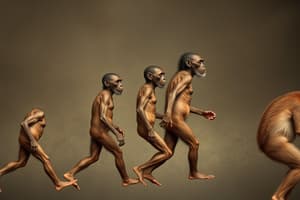Podcast
Questions and Answers
What significant discovery was made in 1856 related to Homo Sapiens?
What significant discovery was made in 1856 related to Homo Sapiens?
The Neanderthal Man was discovered in Neanderthal valley near Dusseldorf, Germany.
What are two regions where Cro-Magnon Man is believed to have lived?
What are two regions where Cro-Magnon Man is believed to have lived?
Cro-Magnon Man lived in Europe and Asia.
How did the brain capacity of Homo Sapiens contribute to their survival?
How did the brain capacity of Homo Sapiens contribute to their survival?
A larger and more complex brain allowed Homo Sapiens to develop survival skills and adapt to their environment.
What unique gripping capacity do humans possess compared to other primates?
What unique gripping capacity do humans possess compared to other primates?
What role did burial practices play in understanding Homo Sapiens' culture?
What role did burial practices play in understanding Homo Sapiens' culture?
Who discovered the Cro-Magnon Man and in what year?
Who discovered the Cro-Magnon Man and in what year?
Name one type of tool or art produced by Cro-Magnon Man.
Name one type of tool or art produced by Cro-Magnon Man.
What is the average brain weight of Homo Sapiens?
What is the average brain weight of Homo Sapiens?
What characteristics define Homo Sapiens compared to earlier human species?
What characteristics define Homo Sapiens compared to earlier human species?
How is Homo Habilis commonly referred to and what major advancement is it known for?
How is Homo Habilis commonly referred to and what major advancement is it known for?
What is the significance of Homo Erectus in the evolution of early humans?
What is the significance of Homo Erectus in the evolution of early humans?
Who discovered the fossil known as 'Peking Man' and when?
Who discovered the fossil known as 'Peking Man' and when?
What evidence supports the hunting and gathering lifestyle of Homo Sapiens?
What evidence supports the hunting and gathering lifestyle of Homo Sapiens?
Explain the evolutionary timeline of Homo Sapiens.
Explain the evolutionary timeline of Homo Sapiens.
What distinguishes the physical structure of Homo Erectus from earlier species?
What distinguishes the physical structure of Homo Erectus from earlier species?
Name two early human species and describe their characteristics.
Name two early human species and describe their characteristics.
What key trait distinguishes Homo Sapiens from earlier hominids in terms of tool use?
What key trait distinguishes Homo Sapiens from earlier hominids in terms of tool use?
How did Homo Habilis contribute to the early development of human tools?
How did Homo Habilis contribute to the early development of human tools?
Which species is known as the first hunters, utilizing axes and knives, as well as discovering fire?
Which species is known as the first hunters, utilizing axes and knives, as well as discovering fire?
What is one of the defining characteristics of Hominids in comparison to other primates?
What is one of the defining characteristics of Hominids in comparison to other primates?
How does the cognitive ability of Homo Sapiens relate to their social behavior?
How does the cognitive ability of Homo Sapiens relate to their social behavior?
Why is the ability to produce art significant in the evolution of Homo Sapiens?
Why is the ability to produce art significant in the evolution of Homo Sapiens?
What role did tool-making play in the survival of early human species?
What role did tool-making play in the survival of early human species?
What can be inferred about the social structures of Homo Sapiens based on their art production?
What can be inferred about the social structures of Homo Sapiens based on their art production?
Study Notes
Human Evolution and Adaptation
- Adaptation capability rooted in human progression and characteristics.
- Recognition of 15 to 20 early human species by scientists.
Hominids and Early Manlike Primates
- Hominids evolved approximately 40 million years ago.
- Manlike primates include notable species:
- Ramapithecus
- Lucy (Australopithecus)
Homo Habilis
- Known as "Handy Man", first to use stone tools.
- Lived between 2.4 to 1.4 million years ago.
- Considered the first true human species.
Homo Erectus
- Dubbed "The Upright Man", existed about 500,000 years ago.
- Lived across Asia, Africa, and Europe; capable of walking upright.
- Had a brain structure similar to modern humans.
- Notable fossils:
- Pithecanthropus Erectus (Java Man) discovered in 1891 in Indonesia.
- Sinanthropus Pekinensis (Peking Man) found in 1929 in China.
Homo Sapiens
- "The Thinking Man", emerged around 250,000 years ago.
- Physical traits akin to modern humans; engaged in hunting, fishing, and agriculture.
- Notable subspecies:
- Neanderthal Man: Lived in caves, linked to hunting and fishing; discovered in Germany in 1856.
- Cro-Magnon Man: First to create cave art and decorated tools; found in Southern France.
Biological Capacities Supporting Cultural Development
-
Thinking Capacity
- Developed brain (averaging 1.4 kg), crucial for complex skills like speaking and sensory interactions.
- Larger brain size facilitated survival skills and adaptation.
-
Gripping Capacity
- Unique human thumb allows opposing finger grip, aiding manipulation of tools and objects.
Studying That Suits You
Use AI to generate personalized quizzes and flashcards to suit your learning preferences.
Related Documents
Description
This quiz explores the progression and characteristics of early human species, highlighting the adaptability and evolution of manlike primates. Test your knowledge on the various species of hominids and their significance in human evolution.



